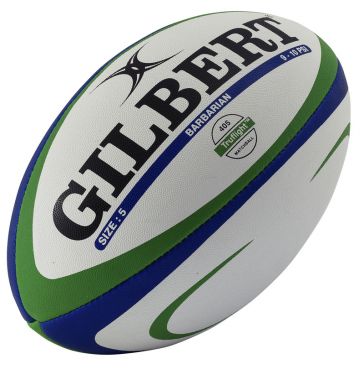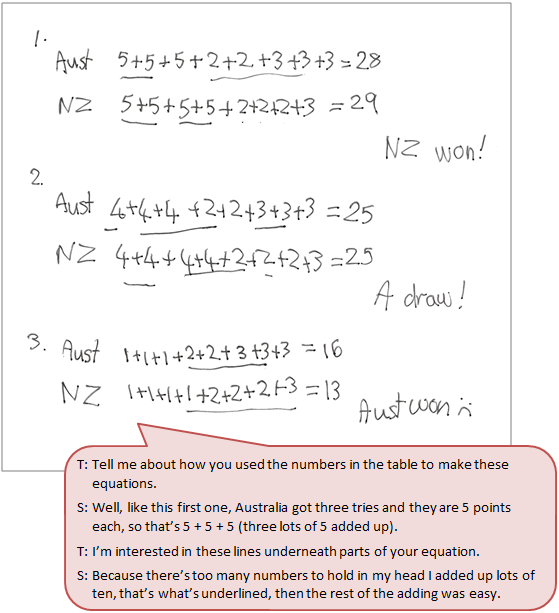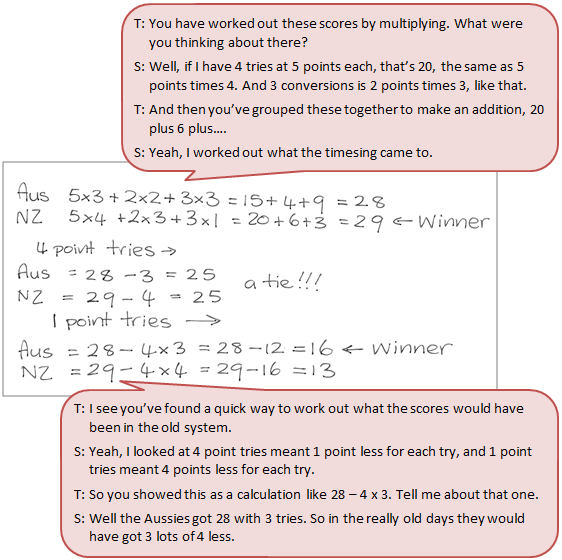The purpose of this activity is to engage students in using operations on whole numbers to investigate a given context.
This activity assumes the students have experience in the following areas:
- Adding and subtracting whole numbers.
- Applying equivalence to solve problems.
The problem is sufficiently open ended to allow the students freedom of choice in their approach. It may be scaffolded with guidance that leads to a solution, and/or the students might be given the opportunity to solve the problem independently.
The example responses at the end of the resource give an indication of the kind of response to expect from students who approach the problem in particular ways.

In the third Bledisloe Cup match between Australia and the All Blacks, in 2014, the game was won by just one point.
- The table below shows the number of tries, conversions and penalties each team scored and the number of points each is worth. Use the table to work out which team won the game.
- Before 1992, a try was only worth 4 points. If the value of a try was never changed to 5 points, would the same team have won the game?
- The earliest scoring system for rugby was just 1 point for a try, 2 for a conversion and 3 for a penalty. If rugby scoring had remained as this original system, who would have won the game?
| Tries | Conversions | Penalties | |
| Points for each | 5 | 2 | 3 |
| Australia | 3 | 2 | 3 |
| New Zealand | 4 | 3 | 1 |
The following prompts illustrate how this activity can be structured around the phases of the Mathematics Investigation Cycle.
Make sense
Introduce the problem. Allow students time to read it and discuss in pairs or small groups.
- Do I understand the situation? (Students who are unfamiliar with rugby will need help understanding what the terms “try”, “conversion” and “penalty” mean.)
- Does the table make sense? Can I explain it?
- Do I expect that changing the points for each action (try, penalty, conversion) will make a difference to a team’s total score? Why will it make a difference?
- Do I expect there to be a pattern to the effect of changes?
- What will my solution look like? (The solution will be decisions about which team won under each scoring scheme that are supported by calculations of total numbers of points.)
Plan approach
Discuss ideas about how to solve the problem. Emphasise that, in the planning phase, you want students to say how they would solve the problem, not to actually solve it.
- What strategies will be useful to solve a problem like this? (A table is given and might be used to organise the calculations. However, equations might also be a good representation if the numbers and operators can be explained.)
- How do I expect the scoring schemes will change the total? Can I anticipate the effect?
- What tools (digital or physical) could help my investigation?
Take action
Allow students time to work through their strategy and find a solution to the problem.
- Am I recording systematically so my calculations are easy to understand?
- Have I looked for efficient ways to find the total number of points?
- Which operations am I using? Do the operations make sense?
- Has my prediction, about the effect of changing points for each action, worked?
Convince yourself and others
Allow students time to check their answers and then either have them pair share with other groups or ask for volunteers to share their solution with the class.
- Do I have a solution that meets the requirements of the task?
- Is my working clear for someone else to follow?
- How would I convince someone else I am correct?
- Is my rule expressed in a mathematical way?
- Is there some mathematics I need to learn to solve similar problems?
- What have I noticed that seems to work all the time in these types of problem?
- Can I recommend a good points scheme? What is my argument for that scheme?
Examples of work
Work sample 1
The student uses chains of addition to find the total number of points for each team. They compare total number of points for each team under the different scoring schemes.
Click on the image to enlarge it. Click again to close.
Work sample 2
The student combines multiplication, addition and subtraction to find the total number of points for each team. They compare total number of points for each team under the different scoring schemes.

